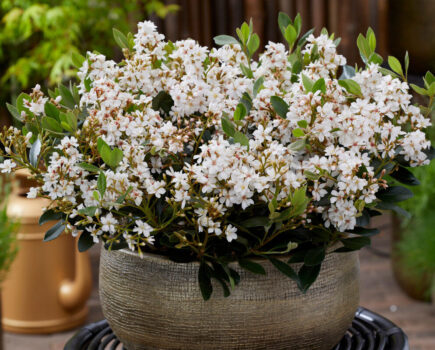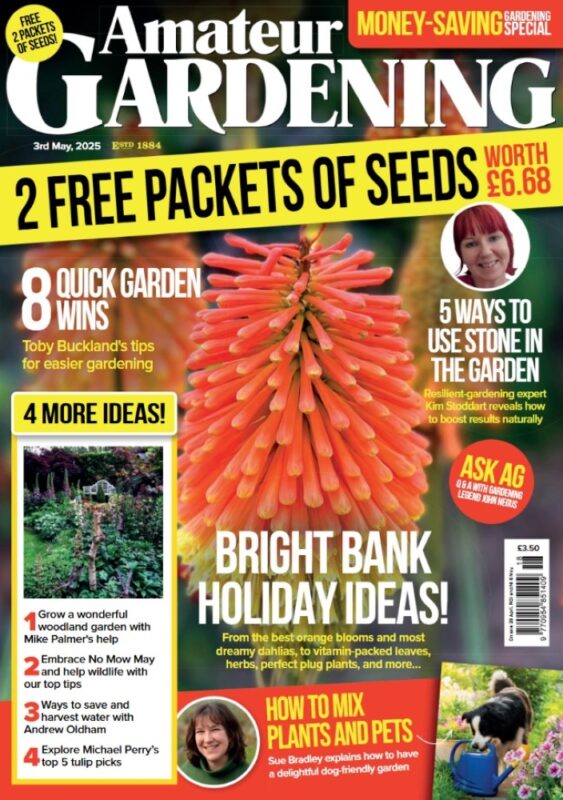Keeping them contained will save a lot of problems, says Toby
The origin of the word ‘bamboozled’ may have been lost in the mists of time, but you don’t need to be Poirot to know it refers to bamboo – a plant that’s more puzzling than an Agatha Christie with missing pages.
As a student working in a botanic garden, I discovered that bamboo is a close relative of lawn turf and part of the Poacea, aka the grass family. It shares the same genes and clambers in the same family tree, but, like Arnold Schwarzenegger to its Danny Devito kin, its roots will threaten with an ‘I’ll be back’.
Perhaps the most puzzling aspect of woody bamboos is the way most species flower ‘gregariously’. This means that plants of the same type, no matter where they grow on the planet, suddenly and enthusiastically flower at the same time. Sometimes the plants die after blooming, but not always and these events can occur randomly from three to 150 years apart.
By flowering at the same time, the likelihood that their wind-pollinated blooms will be cross-pollinated ensures genetic diversity within the species. But what triggers the event and how the plants know when to flower is still a mystery.
Avoid spreading bamboo


Never seen a bamboo in bloom? It’s quite a sight. The usually straight canes develop a mass of side-shoots making each one look like the tail of a giant cat that’s had a fright. This can happen sporadically on just one plant or even the odd cane and although it’s often said that bamboos that flower die, they won’t if fed and watered to top up their reserves.
In my garden I grow the golden Phyllostachys aurea for its cheerful yellow stems and I chose it for the claim on the label that it’s a clump former as opposed to a ‘spreader’.
When buying any bamboo, this distinction is important, as spreading types know no boundaries, while clumpers are non-invasive so don’t rush to take over yours or your neighbour’s garden – or the nearby park.
I say ‘won’t rush’ as after 10+ years, my clump-former is suddenly spreading and throwing up thick new shoots among its neighbours. Although puzzling, I think I know why.
Bamboo likes woodsy conditions, i.e. soil that’s deep and moisture retentive and mine is in the crowded living quarters of a raised bed. The free-draining soil combined with last summer’s drought has triggered my plant to literally ‘up sticks’ and look for greener pastures.
In the stone-edged raised bed this isn’t a problem, in fact I like the idea of it taking over and forming an homogeneous screen. But should new shoots spread to where they shouldn’t, I’d be on it as quick as a whip to chop out the unwanted growth before the running roots get a grip on the surrounding soil and harden.

If you’re thinking of planting a bamboo, take my plant’s recent behaviour as a cautionary tale. Climate change and the predicted long dry spells are likely to trigger more ‘tame’ bamboos to go on the run, so when planting any bamboo, it’s prudent to contain the roots within a barrier.
If you have a stash of corrugated iron or paving slabs behind the shed, these set on edge will do the job or use hefty rubber root-barriers buried in the soil at planting time. They cost around £40 for a 5mx70cm (2ftx3in) length and can either be set out in a circle around a newly planted or existing bamboo (make sure to overlap the ends by at least 50cm (20in) or use like a wall to stop bamboo or bindweed coming in under a fence. When setting in the soil leave 10cm (4in) above ground.
There’s also a high-tech option of copper-lined barrier fabric. Like rubber, it physically blocks root growth but has a super-power as the copper in the weave is repellent to roots, causing them to grow in the opposite direction. The fabric also comes in convenient, pre-made planting bags.
Dig a hole, drop in the bag (leaving the top 10cm (4in) above ground so that the bamboo can’t run over the top and hide the exposed strip with a layer of bark) and fill with soil and then plant as if the bag wasn’t there. A 95litre bag costs around £27.
Thin plants for extra beauty

Retro-fitting barriers to a bamboo clump is hard graft but there is another way to reduce vigour that has the added benefit of enhancing the plant’s beauty.
Rather than leave to form an impenetrable thicket, removing all of the oldest canes creates more space within the plants existing footprint for new shoots to rise, making them less likely to pop up where they’re not wanted.
The old canes are easy to spot, as they’re duller in colour and have angular side-shoots. I use a hacksaw for this job, but a small pruning saw is just as good. Always take care to chop as low to the ground as possible, as any stubs will persist for years and catch the back of your hand the next time you’re pruning.
A thinned bamboo is beautiful bamboo, transforming old clumps, making them brighter and more airy, and especially gorgeous when sun sparkles through the canes.
I also cut my bamboo for stakes for beans and use the canes for propping up floppy herbaceous plants. Even the wiry side-shoots come in handy for giving allium seedheads a second wind.
Alliums have hollow stems that means they’re easily toppled by summer squalls. But push a thin length of bamboo up inside and you give the seedheads a solid spine that you can push in anywhere around the garden. Genius!
Give it a go and if anyone asks why yours look so good tell them it’s like bamboo, a mystery!
There are 1718 known species of bamboo worldwide, of which 101 have edible shoots cut like asparagus while the shoots are small and tender. Like bitter almonds, they contain large concentrations of cyanogenic glycosides (toxins that are the basis of cyanide) but cooking in boiling water eliminates any toxicity.
Find more tips, advice and articles like this at the Amateur Gardening website. Subscribe to Amateur Gardening magazine now





